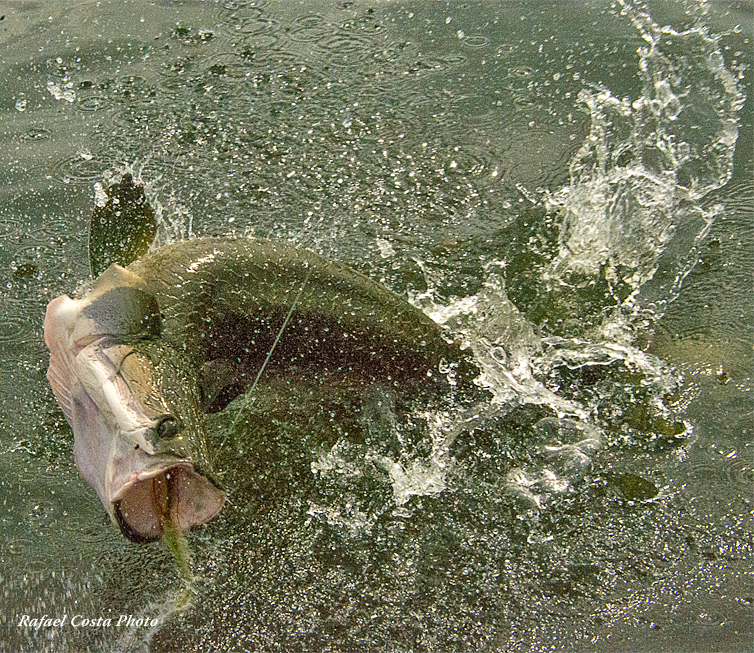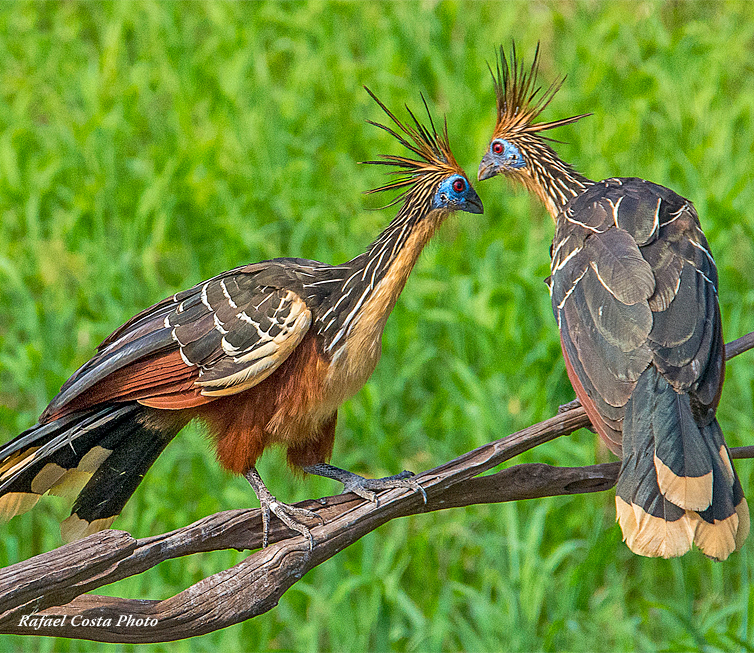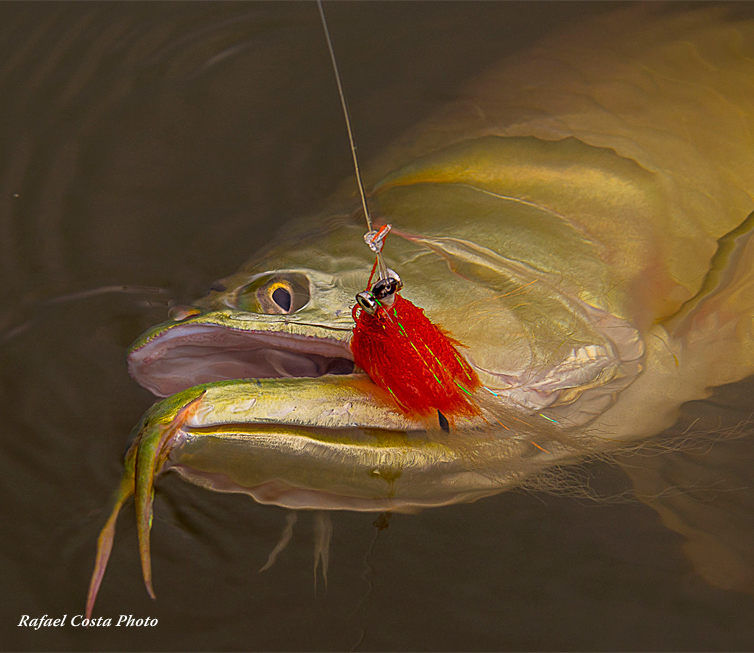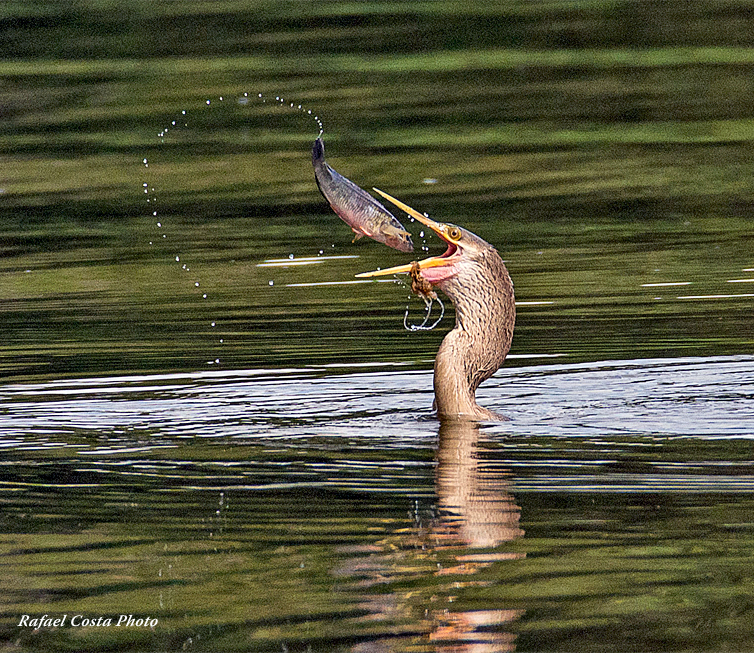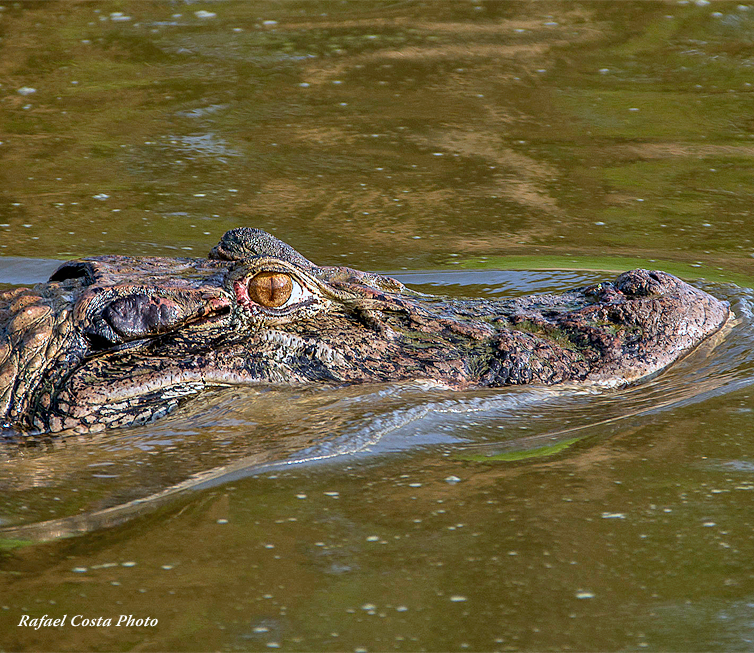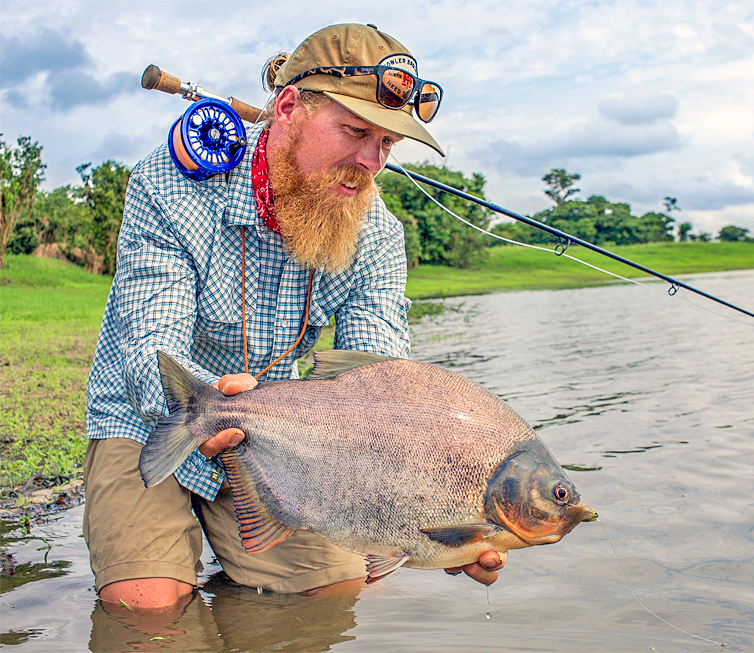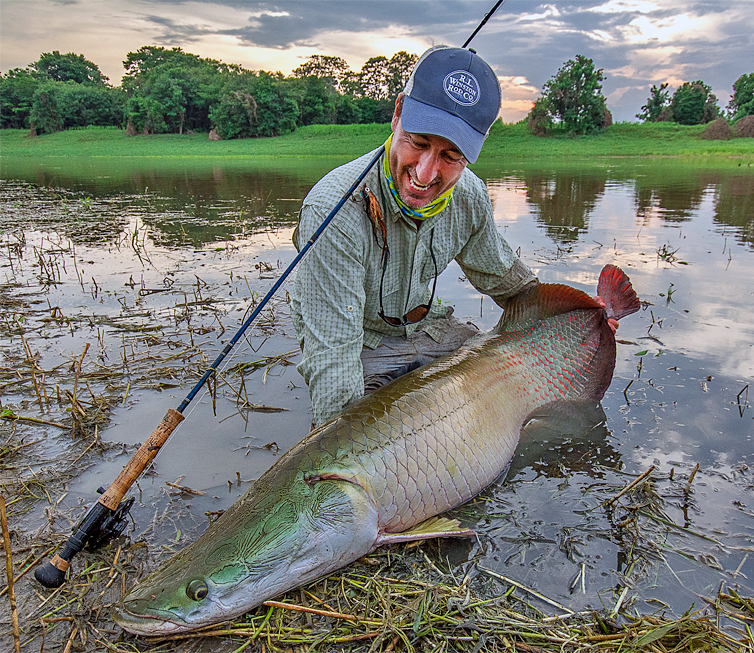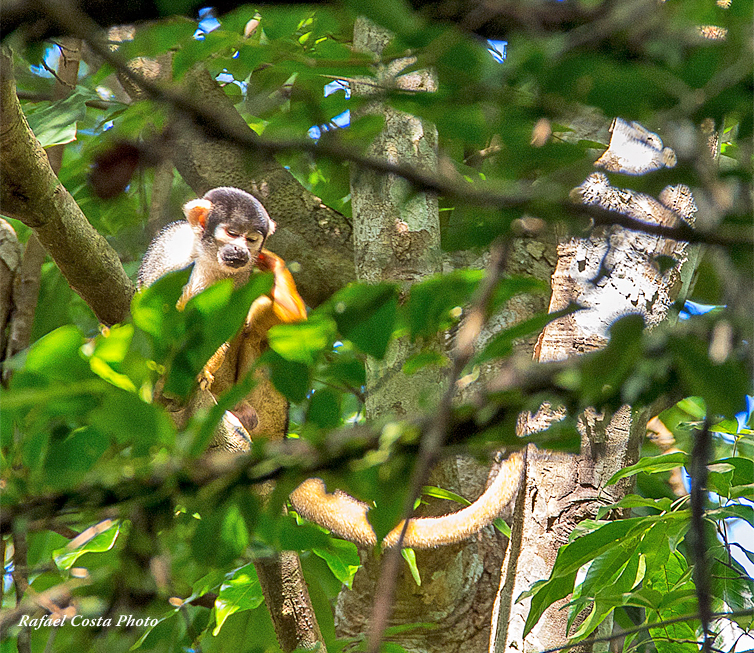In the fall of 2015 The Fly Shop® and Untamed Angling explored a brand new destination deep in the heart of the Amazon: Pirarucú! Untamed Angling, the same angling pioneers that introduced the world to the exciting golden dorado fishing at Tsimane in Bolivia and the river of peacock bass giants at Rio Marie’ in Brazil, have once again organized a collaboration with the indigenous Indian communities and the Brazilian government to protect a unique jungle fishery through eco-tourism and catch-and-release fly fishing. Pirarucú will follow the example set by both Marie’ and Tsimane, a partnership between fly fishermen, the local Indian Community, and the Brazilian government to form the largest protected reserve on earth for yet another unique and special species, the arapaima.
Arapaima are the largest scaled freshwater fish in the world, reaching lengths of up to 9 feet long and weighting up to 440 pounds. They are an air-breathing fish, resembling tarpon in both size and shape, though with more coloration and distinctly prehistoric fins. They have a wide, scaly, gray-hued body and a tapered head, often with deep red coloration along their fins. Arapaima can stay underwater for long periods of time (up to 20 minutes), but they tend to hold closer to the water’s surface where they can hunt smaller fish. When hooked, they are acrobatic fighters, leaping repeatedly out of the water.
While fishing for a true river monster is appealing for a lot of adventure anglers, Pirarucú has much more to offer than just big fish. In our 2015 exploratory season we did land giant arapaima of up to 150 kilos (330 pounds!), we also discovered several other remarkable, unique, and exhilarating fisheries here in the Mamirauá Reserve. In addition to the large fish, we found vibrant populations of “juvenile” arapaima from 20-60 pounds, which readily take large streamers on floating fly lines in the shallow lagoons of the reserve. There are also many arowana, a fish popular in aquariums in the US but that average 2-8 pounds in the wild and attack poppers and terrestrials with reckless abandon, instantly leaping acrobatically high into the air once hooked. And one can’t pass by the schools, singles, and pairs of cruising tambaqui often sighted along the banks, fish that resemble freshwater permit in size, shape, and their hard-pulling nature on the end of a fly line. Throw in potential for yellow peacock bass, piripitinga, red-bellied piranhas, and oscars, and you have the recipe for an incredibly diverse fishery that will not disappoint any jungle angler.
The unique fishery at Pirarucú is certainly the primary draw to the region; once settled into your floating cabin at the Pousada Uacari, however, you’ll quickly be amazed at the incredible nature of the place itself. The floating lodge is perched in a bend of the channel that connects the series of lakes and lagoons to the junction of the Solimões (Upper Amazon) and Japura Rivers. You’ll be immersed in jungle, surrounded by the sights and sounds of massive arapaima rolling and splashing in all directions (and at times literally right beneath the floor of your cabin!) As a bonus, the Mamirauá Reserve is one of the top birdwatching destinations in the world, and every day you’ll see countless species of birds along the banks and within the dense jungle.
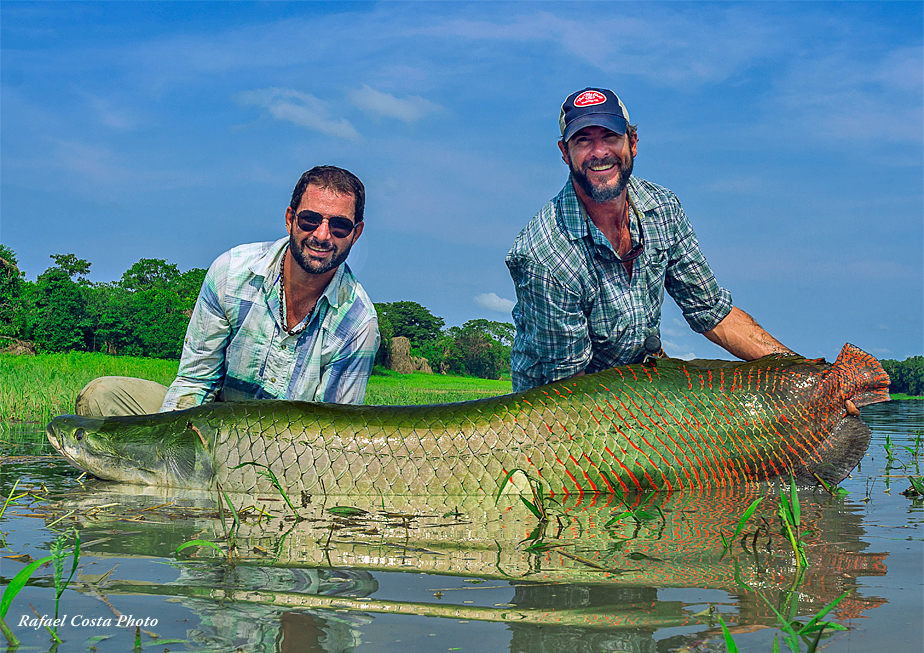
Reservations & Rates
The cost of the 5 night/4.5 day Pirarucú package is:
• Angling: $5,550 USD per person (Double Occupancy (shared guide and room))
• Non-Angler: $2,885 USD per person (Double Occupancy)
* All trips also have a 10% Native Community Fee
The cost of the 7 night/6.5 day Pirarucú package is:
• $6,590 USD per person (Double Occupancy (shared guide and room))
• Non-Angler: $3,450 USD per person (Double Occupancy)
*All trips also have a 10% Native Community Fee
*Single room and private guide/boat options are available.
Inclusions
Included in your angling package at the Pirarucú is all boat transfers / All necessary ground transfers in Brazil / 5 days fishing, fully guided / 6 night, all inclusive: lodging, meals, and beverage (including wine, beer and spirits) / One overnight at the Tropical Hotel in Manaus on arrival / Guided-operated 20 foot fully equipped shallow draft skiffs per two anglers / Fishing licenses / Daily laundry at fishing destination.
Non-Inclusions
Not included in your angling package at Pirarucú are 10% Native Community Fee / International air fare / Domestic Airfare – Manaus-Tefe-Manaus (around US$150) / Brazilian visa (no longer required after June 17th, 2019) / Tips and gratuities for camp staff and guides / Food and beverages in Manaus and private city tours / Airport departure tax / Satellite phone calls ($5/minute) / City tours in Manaus / Extra hotel overnights / Flies (we have an extensive selection of best flies at Camp - $10/each).
Native Community Fee:
This Project was based as a long term social project which supports the preservation of the Indian Culture by improving their quality of life. The project has a significant user fee on all visiting anglers. The funds from the fee will primarily be used for social projects, infrastructure development, transportation, and medical and education projects.
The fee will be 10% per person for the trip. The tax will be payable in (Cash $USD or Brazilian Reals) to our representative at your arrival in Manaus and goes directly to the Indian Association account and anglers will receive a receipt from the association. This fee represents an important step in the continuing effort to protect our ability to continue to share this amazing and unique part of the world.
Travel Insurance
The Fly Shop® is not in the insurance business, but we recommend Travel Guard coverage as a service with a desire to see your best interests protected. It is impossible to know when an unfortunate situation (loss of luggage, fly rods, illness in the family, or an accident) may occur. However, such things can and do happen, and this insurance can provide a means of recourse against non-refundable financial losses.
• Travel Insurance Information
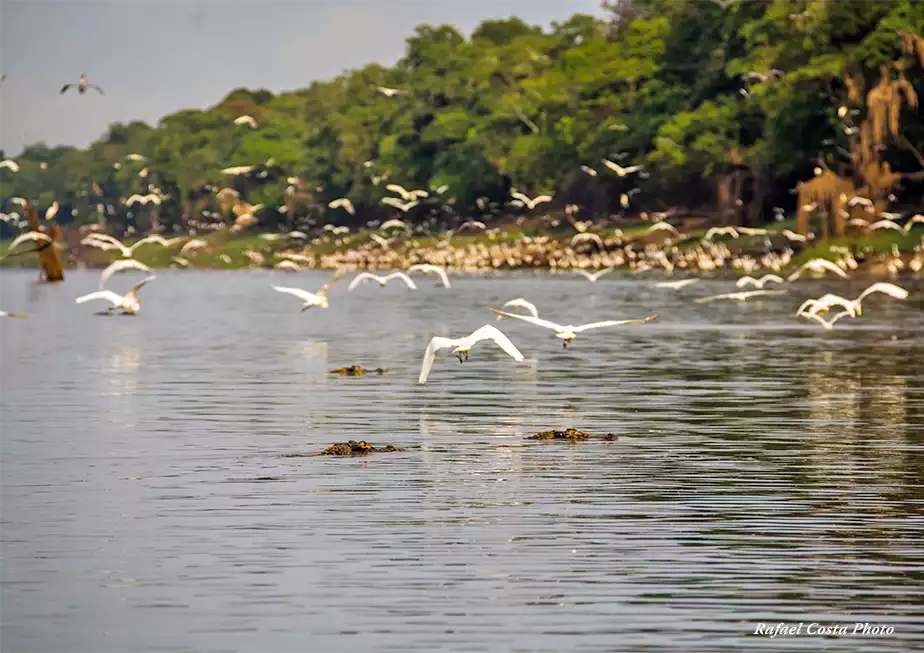
Seasons at Pirarucú
The season runs from early September to the end of November. The dry season in this part of the Amazon runs from July through January, so this season focuses on the middle of the dry season when water should be low and fish congregating in the lakes and channels. Nov. 31st marks the end of fishing due to special regulations from the Environmental Authorities in Brazil who close any kind of fishing for Arapaima anywhere in the Amazon to protect juvenile fish.
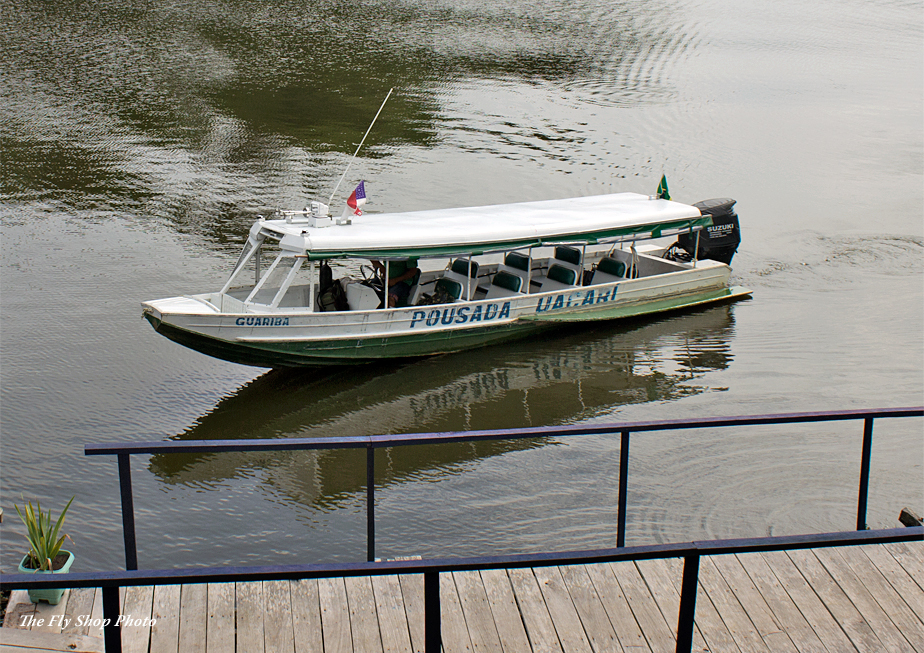
Getting to Pirarucú
Getting to the Mamirauá Reserve is relatively simple. First you will travel from your home to the City of Manaus in Brazil, the “gateway to the Amazon.” The first overnight at a comfortable hotel in Manaus is included in the trip package. From Manuas, you must reserve a commercial flight on Azul Airlines to the town of Tefé, which can be done on-line on their website or through a travel agent such as Alicia Regueiro from Holdy Tours. The flights are around $85 one way, or $165 round trip. They are a good airline with new clean planes, and you fly in a small jet. The flight lasts almost exactly one hour.
Read More
In Tefé, you are greated by a representative of the lodge with a sign for Pirarucu', who will load your gear into the back of a truck for the short, 5 minute drive across the small town of Tefé to the river. The town is bustling with scooters and motorcycles, and with a population of about 70,000 people it's busy but not a huge city. At the river you'll load your luggage into a large white and green "fast boat", a long narrow vessel with six rows of seats on either side of the center aisle, high metal sides with open windows and a roof for shade.
From Tefé it is about one hour scenic boat ride to the Uacari Lodge, up the mighty Solimôes river, then a right turn up the Japurá River, finally heading into the mouth of the Reserve and ending at the lodge. It is an interesting trip, seeing plenty of boats of all shapes and sizes moving up and down the river, and a few small indigenous communities located on stilts high up on the river bank, a hint of how high the water can get during the high season. Keep an eye out for pink dolphins, as they are around in this part of the river and it's not uncommon to see several on your way in to the floating lodge.
Sample Itinerary:
Day of Arrival:
Upon arrival at Manaus International airport, guests will greeted by our English speaking representative/transfer driver. They will arrange for transfers to the Hotel Tropical. You and another angler will be put up in a Double Occupancy room at the Tropical for the night (included in the trip package). The transfer staff will let you know when they will pick you up at the hotel the next morning, to take you to the airport for the domestic flight. It is best to arrive in Manaus a day earlier rather than late at night the night before heading into the jungle – this helps buffer you against possible airline delays into Manaus, and will give you a day to enjoy what Manaus has to offer. This is important as there is only one flight a day to Tefé. It costs an additional hotel night, but for many it is worth it, for the peace of mind.
Friday – Day 1:
Enjoy your complimentary breakfast at the Hotel. The host will pick up the group at approximately 12:00 pm and head to Manaus airport to take the Azul Airlines Flight#5244 to Tefe, which departs at 8:00 am and arrives in Tefe at 9:15 am. The commercial flight is not included in the package price, and you will want to reserve this flight in advance. A lodge representative will meet you at the airport in Tefé and take the group to the port to board the fast boat to the lodge, roughly a one hour trip. Once you arrive at the lodge you will meet the fishing team and staff, prepare your tackle, and head out for the first half day of fishing.
Day 2-5 (4 Full Days of Fishing):
Each day individual teams (2 anglers) will head out for the day and fish one of the beats in the Pirarucú area, its tributaries and or lagoons. Each two anglers will share a fly fishing guide along with a local native guide in specifically designed fly fishing boats with two large casting platforms. Both anglers are constantly fishing, all day long from these perfectly designed boats.
Typical Day:
5:30 am – Coffee is hot
6:30 am – Breakfast
7:30 am – Head to fishing grounds
12:00 pm– Anglers will have a short ride back to the lodge for lunch.
2:30 pm – After lunch, fishing will resume until late afternoon when the guides will deliver anglers back to the lodge around 6:00 pm.
6:30 pm – Cocktails and appetizers
7:30 pm – Dinners will be served inside the dining room area.
Wednesday - Day of Departure:
After breakfast, you will take the fast boat ride back to Tefé, then transfer to Tefé Airport in time to board the commercial flight from Tefé back to Manaus on Azul Airlines (Flight #4245), departing around 9:45 am and arriving back to Manaus around 10:50 am.
Once back in Manaus, some anglers will be departing on the late night flight that evening or very early the following morning. Your staff driver will deliver you to the International Airport after a nice Brazilian BBQ dinner (we highly recommend the Bufalo Restaurant (not included)) or to the Tropical for a quick shower if you choose to rent a day room. If you do not feel like taking the red eye out of Manaus that night, another night’s stay at the Tropical can be arranged.
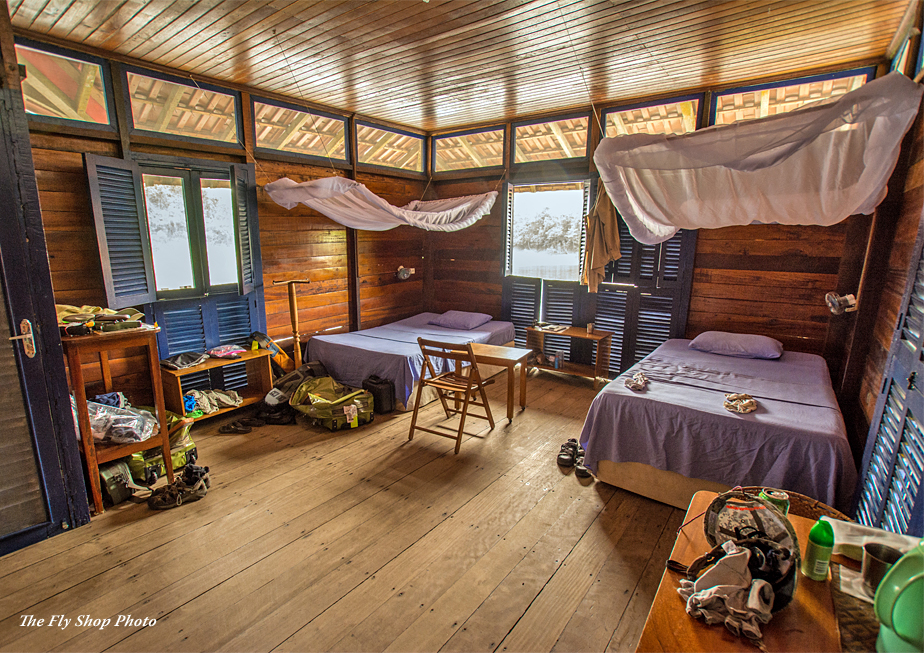
Lodging at Pirarucú
The Uacari Lodge is a floating lodge, constructed of local woods. It is simple and very comfortable and beautiful. It is utilized during other times of year as an ecotourism lodge primarily for birdwatching and wildlife viewing, and is fact noted as one of the top five birdwatching areas in the Amazon. All of the buildings are supported by a type of very large tree that floats in the water and is found in the jungles around the lodge. In the center is a dock for boats to pull up, with a covered "palapa" and a large table and some chairs to relax out on the front deck. Beyond
Read More
that is the main lodge building, a two-story structure housing the kitchen, dining room, bar, and a few couches for lounging. The lodge and all of the cabins are connected by a series of wooden walkways.
To either side of the main dock and deck wooden walkways run to both directions connecting to the guest rooms. There are a total of 5 floating cabins, two on one side and three on the other, all connected with these floating wooden gangways. Each building has two rooms, for a total of 10 rooms. All rooms have en suite full bathrooms with flush toilets and good hot-water showers.
The lodge is eco-friendly, so entirely run on solar electricity. The rooms are spacious with lots of screened in windows for air flow, and there are fans by the bed and ceiling fans to help with additional airflow at night. There are no plugs in the rooms, but a couple of multiple plug outlets are available in the main lodge for charging electronics. There is fairly reliable, albeit slow, wifi that is best in the lodge but does also reach to the rooms.
The sounds of Arapaima (and the large ever-present black Cayman that frequent the area) are constant.
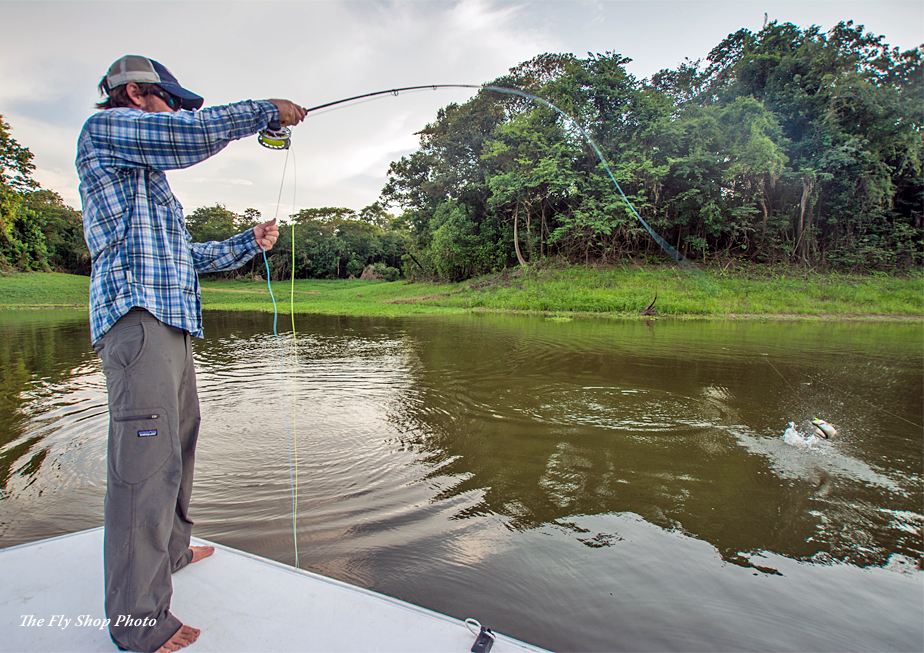
Fishing at Pirarucú
Pirarucú is located within the Mamirauá Reserve, about 600 km west of Manaus. Mamirauá is a complex of lakes, lagoons and channels between the Solimôes River and Japura River. Mamirauá was the first Sustainable Development Reserve in Brazil, legislated by the Government of Amazonas in 1996, and remains the largest Arapaima reserve in the world. The purpose of a Sustainable Development Reserve is to find a balance between biodiversity conservation and the sustainable development of an area inhabited by human populations. Mamirauá
Read More
covers an area of 1,124,000 hectares. Because it is protected, it has a healthy and remarkable population of wildlife, especially birds. In fact, it is one of the top birdwatching destinations in the world. Located in the heart of the protected ecological zone is the Uacari Lodge, named for the Uacari monkeys that the ecological reserve was originally designed to protect. Many other monkeys including several types of howler monkeys and spider monkeys also live in the reserve, along with plenty of jaguars. And lots of large black cayman.
In the high water season the waters from these two rivers flood the jungle of the reserve. In the low water season, which corresponds to the fishing season from mid-September through November, these inland lakes and lagoons are connected by a series of naturally occurring canals and channels, creating ideal habitat for a variety of aquatic species including arapaima, arowana, tambaqui, yellow peacock bass, piripatinga, piranha, oscars, payara, and many small varieties of baitfish.
Anglers exploring Pirarucú will fish both the inland lakes system - formed in the rainy season from January through June when high water floods the inland jungle areas, then drop during the dry season - and the system of channels that remain to connect them all to the main waterways.
Our initial exploratory season in 2015 taught us that this region has unbelievable potential for the adventure angler. Obviously with only one brief exploratory season under our belts, there remains much to learn, but the feedback from our staff and guests was off the charts.
So far we have discovered at least four "unique" fisheries at Pirarucú:
Big Arapaima:
Arapaima are the largest scaled freshwater fish on earth, and the current world record on the fly is 440 pounds. You will see fish in the 100, 200, 300, even 400 pound range on a daily basis at Pirarucú, as they roll and splash on the surface. We find these bigger fish in the lagoons at times, while they are more concentrated in the deeper channels and near the lagoon mouths. A 12 weight rod is the best tool for these river monsters, with a heavy-sinking (450-500 grain) line.
"Small" Arapaima:
These fish range from 20-100 pounds and are found in good numbers in the shallow lagoons, inland lakes, and along the edges of the lake and channels. These fish hit a fly incredibly hard and, once hooked, they pull extremely hard and frequently explode in acrobatic aerial displays. Floating or Intermediate lines are best, on either a 10 or 12 weight rod. When these "small" arapaima are actively feeding in shallow water, they offer consistent action with multiple hookups.
Arowana:
Arowana are a well-known aquarium fish that reside here in vast numbers. They range from 2-10 pounds and swim just below the surface, presenting excellent sight-casting opportunities. And they love topwater flies. They are a finicky fish, at times hyper-aggressive (to the point they'll take the same giant streamers used for arapaima) and at times very spooky, making them great light-tackle quary, a fun diversion from casting the bigger rods for the bigger fish. A 7 weight rod is perfect for them, while an 8 weight also works great. Floating line is all you need, with a few poppers and terrestrials.
Tambaqui:
The tambaqui is the "freshwater permit" of the Amazon. A part of the pacu family, these fish range from 5-30 pounds and are very strong and fast. They are omnivorous and will eat fruit, seeds, nuts, or baitfish. You will see large fish in singles cruising along the edges, and at times schools of small/medium sized fish where you can actually spot nervous water as they cruise and feed on pollen and small bugs on the surface, just like permit on the flats! Fruit or seed fly imitations or large beetles work when they are cruising. 8 weight rods are good, while a 7 works too.
The Mamirauá Slam! Many dedicated saltwater anglers vie for a "Grand Slam", landing a bonefish, permit, and tarpon all in the same day. At Pirarucú, we have the greatest Grand Slam challenge discovered to date in jungle fishing: The Mamirauá Slam consists of landing an arapaima, arowana, and tambaqui all in the same day! Make it a "Super Slam" by including a yellow peacock bass, piranha, or Oscar, too!
Why We Endorse This Destination:
Pirarucú Lodge
• The arapaima is the king of all the jungle fish: it is the largest the largest scaled freshwater fish in the world. Arapaima are the jungle equivalent of tarpon; they are an air-breathing fish, resembling tarpon in both size and shape, though with more coloration and distinctly prehistoric fins. They have a wide, scaly, gray-hued body and a tapered head, often with deep red coloration along their fins. When hooked, they are acrobatic fighters, leaping repeatedly out of the water in a cacophonic explosion of water that repeatedly leaves anglers in awe at their power and beauty.
• The Mamirauá Reserve is the largest Arapaima reserve in the world. Mamirauá was the first Sustainable Development Reserve in Brazil, legislated by the Government of Amazonas in 1996. It was originally established to protect the Uacari Monkey, but the protection has enabled the arapaima populations to grow to numbers unheard of anywhere else in the amazon, where elsewhere they are frequently harvested for food. The arapaima are literally everywhere here, ensuring you’ll be seeing and casting to rolling fish all day long, every day.
• Pirarucú has much more to offer than just big, tackle busting fish. Mamirauá is also home to vibrant populations of “juvenile” arapaima from 20-60 pounds, which readily take large streamers on floating fly lines in the shallow lagoons of the reserve. There are also many arowana, a fish popular in aquariums in the US but that average 2-8 pounds in the wild and attack poppers and terrestrials with reckless abandon, instantly leaping acrobatically high into the air once hooked. And one cannot pass by the schools, singles, and pairs of cruising tambaqui often sighted along the banks, fish that resemble freshwater permit in size, shape, and their hard-pulling nature on the end of a fly line. Throw in potential for yellow peacock bass, piripitinga, red-bellied piranhas, and oscars. This is an incredibly diverse fishery that will not disappoint any jungle angler looking to check off half a dozen exotic species on his bucket list, deep in Amazonia.
• The wildlife in the Mamirauá Reserve is incredible! Once settled into your floating cabin at the Pousada Uacari, you’ll quickly be amazed at the myriad of life all around you. The floating lodge is perched in a bend of the channel that connects the series of lakes and lagoons to the junction of the Solimões (Upper Amazon) and Japura Rivers. You’ll be immersed in jungle, surrounded by the sights and sounds of massive arapaima rolling and splashing in all directions (and at times literally right beneath the floor of your cabin!) As a bonus, the Mamirauá Reserve is one of the top bird watching destinations in the world with over 400 recorded species, including, toucans and Harpy eagles. Every day you’ll see countless species of birds along the banks and within the dense jungle.

